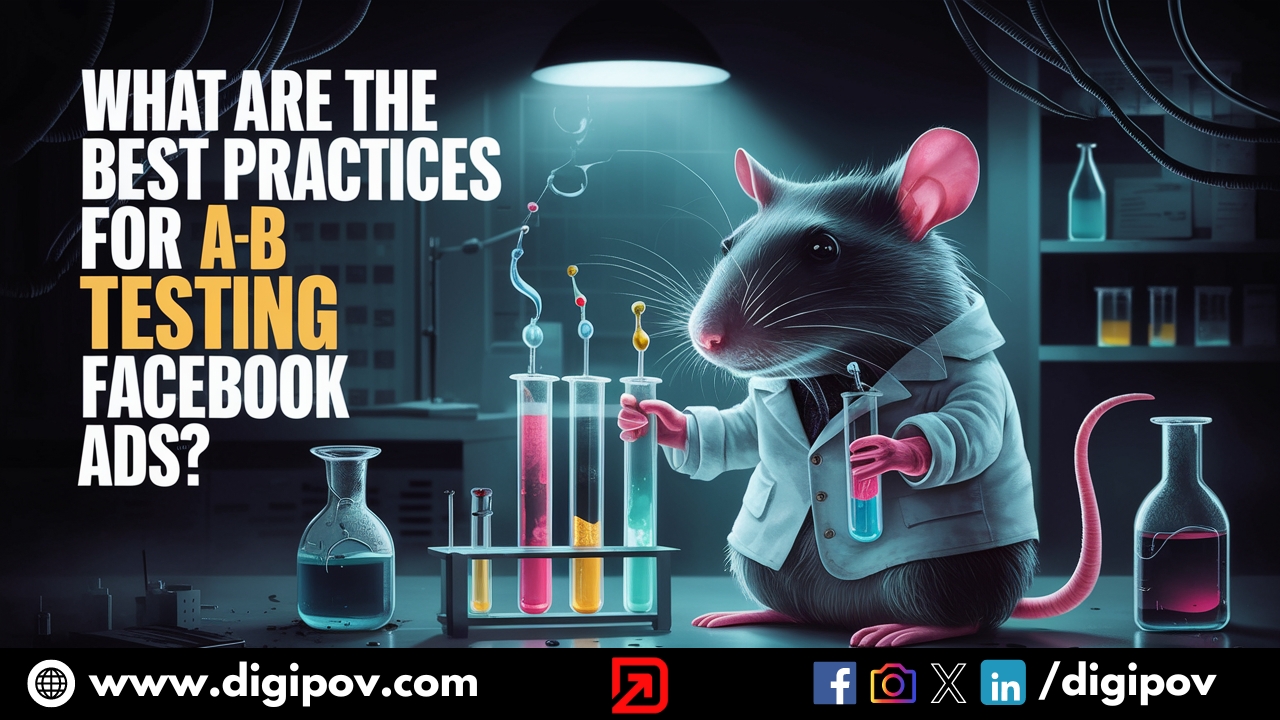From my experience testing is never wrong or right , it can benefit you in many different ways. Mostly people do not opt for testing because of low funding as they are afraid of wasting money on ads. But in case you need to get the most from your ads you need to do testing. A/B testing is a boon for online marketers as it allows them to determine which elements of advertising are working and which are not. Facebook is among the most popular platforms for marketing hence, it is important to understand the top methods for A/B testing in Facebook advertisements. In this post, we will explore the most effective techniques that you can utilize to carry out successful A/B experiments on Facebook.
Defining objectives
Before launching any campaign Facebook gives us a list of objectives that we want to optimize as our end goal. It may encompass recognition of the brand, creation of potential leads, increase in page likes, conversions, and more. Setting clear objectives is vital prior to initiating any testing, depending on the desired end result. It is important to define your objectives and the KPIs (key performance indicators) you choose to evaluate them . Having a specific goal in mind enables you to develop more effective tests and draw more insightful conclusions if you have a defined goal.
Test one variable at a time
When you are a beginner in testing , it is best to test one variable at a time during the A/B test. As use of many variables may confuse you and you won’t be able to differentiate which variable has affected the result. Use of several variables will waste your time and money and lead to wrong conclusions. Hence, by testing one variable at a time, you may properly determine what changes made your ads successful and resulted in the most conversions.
Note: You may not get the same results for every ad. So keep testing and keep improving your ads based on data.
Keep your test groups separate
While testing ads you may have to test your ads with different age groups or demography. Try to maintain separation between your test groups when doing an A/B test to determine which is working best and with which demography. It means that you should only present each group with one version of your ad. You won’t be able to judge which ad did better if you mix the groups or display both versions of the ad to the same group of people. It can lead to a waste of time and money while ending up providing the wrong conclusion.
Use a large enough sample size
To verify that the findings of an A/B test are statistically noteworthy, a big enough sample size is necessary. Findings from tests with a small sample size might not be trustworthy or accurate. It may lead you to the wrong conclusions and waste your time and resources. You need to use a large sample size for more accurate results. A good rule of thumb is to have at least 100 conversions per variation before reaching any decision.
Test over a long enough period
Testing is always better while running ads on Facebook or any other platforms as it can give us notes on how to enhance your ads and get more results. Patience is also important as you don’t want to hurry and ruin your progress. So while you are performing A/B tests, it’s best to test for a longer amount of time to guarantee that the results are of quality. You cannot get a clear vision of how your ads are working overtime if you test them for a short period. It can waste time and money and result in wrong deductions. You should always think about how long your sales process is and how long it takes for your ads to produce noticeable results when you choose the right test period.
Use a control group
To do an A/B test, it is important to have a control group. This is a type of a group in which one can neither see the advertisement nor the original version of it. The results from the test group and the control group can then be compared. Thus, one can derive whether or not his/her advert has any effect on its target audience
Monitor your results regularly
While running ads online, ensure you monitor your performance regularly . Running ads online involves optimization and monitoring activities that must be done daily. Regular checking of results is necessary when undergoing A/B tests. This will help you notice any problems early enough and make appropriate adjustments for better performance. By watching your conversions, you should wisely select and enhance ad performance.
Clear and Concise Messaging Should Be Used
Facebook also advises giving an accurate message that is easy to understand to your target audience because it might increase conversions rates. So keeping clear and simple language is a must when doing an A/B test. Your messaging should be simple enough to understand what values are offered by our product or service. This can boost conversion rates as well as click-through rates.
Implement Gradual Modifications
Over time try to make small, gradual modifications when making adjustments to your Facebook ads. It is a requirement to change one variable, little by little, at a time. Try to avoid making significant adjustments that can hurt the effectiveness of your ads. It will assist you to understand what is and is not working.
Test across multiple platforms
Test through all the different platforms and placements if necessary, not just with creatives, Ad copies or demography though. Testing across many platforms/placements is important when carrying out an A/B test. This will help you identify which ones among the platforms/placements are working best for your ad. Cross-platform testing can enable you to optimize your ads better for improved performance and wider audience coverage.
Utilize automation tools
You can also run A/B test ads from Facebook itself as well as test on their platform. Though it may be more efficient to use any online automation tools available to you. Various third-party solutions allow for A/B testing of your Facebook advertising capabilities. AdEspresso, Optimizely, Unbounce such tools allow automated testing, analyzing results and improving advertising. These tools are likely used to provide A/B testing solutions.
To put it simply, using Facebook Ads is one of the best ways to achieve your target audience and increase conversions for your business. Nonetheless, monitoring your Facebook ad ROI is essential if you want to ensure that you are getting the most out of every dime you have invested in advertisement. Google Analytics comes in handy when you need to monitor your Facebook ad ROI as it gives valuable insights about what users do on your site. This article will look at how you can track Facebook ad ROI with Google Analytics.
Step 1: Generate Custom Campaign URLs
You should generate custom campaign URLs to track the return on investment (ROI) of your Facebook ads through Google Analytics. Custom campaign URLs enable you to keep track of specific campaigns and adverts within Google Analytics. It is possible to create custom campaign URLs with either the URL builder tool provided by Google or other different tools which are used by third-party.
When creating a custom campaign URL for a Facebook ad, include these parameters:
• Campaign Source: Where traffic originates from i.e., in this case, Facebook.
• Campaign Medium: What type of traffic it is i.e., social media in this case.
• Campaign Name: The name you have given for this particular campaign.
• Campaign Content: The specific advert or variation of an advert being tracked.
Step 2: Adding custom campaign URLs to your Facebook Ads
Facebook ads are one of the many places where you can add custom campaign URLs. To do that go to Ad Manager and choose the ad you want to track. You will then scroll down the settings of the ad until you see the Website URL, and in this part, insert your custom campaign URL.
Step 3: Connect Google Analytics with Facebook Ads Accounts
Google Analytics has a way of tracking ROI from your Facebook ads and linking it with Facebook ads is what makes it possible. This means visiting Facebook Ads Manager, clicking on “Ads Reporting,” selecting “Settings” at the top right corner followed by “Ad Account Settings.” Next, click on “Add a New Ad Account” and link up Google Analytics account following the instructions.
Step 4: Setting Goals in Google Analytics
Again, for tracking your Facebook Ad ROI on google analytics; goals are what allow for doing so. These include certain activities which may be performed on your website such as buying or just filling out online forms. In order to establish goals, navigate through “Admins” in Google Analytics then select the “Goals” option before clicking “New Goal”. After that simply follow all instructions for setting up a goal.
Step 5: Analyzing your Data
When you have set up these custom campaign URLs, linked your accounts and pinned down your goals, it is time to get down to the brass tacks of data analysis. Go into Google Analytics, go to the “Acquisition” tab and click on “Campaigns”. Here is where all the magic happens – you can see how many people clicked, converted and the amount of money your Facebook ads are bringing.
That’s not all! Google Analytics does not just deal with figures – it is like a backstage pass for your website. You can take a look at which pages visitors visit, how long they stay and what buttons they click. It is a treasure map that will enable you to tweak your Facebook ad game for maximum bang for your buck.
To put it simply, watching over your Facebook ad ROI in Google Analytics is like having a secret weapon. Those URLs tailored specifically just for this purpose as well as those interlinked accounts, goals plus number crunching? They act as a compass that helps you comprehend user behavior while supercharging your ROI. With these tools in hand you will not only optimize your Facebook ad campaigns but also grow our business. Cheers to make these ads work smarter, not harder!



